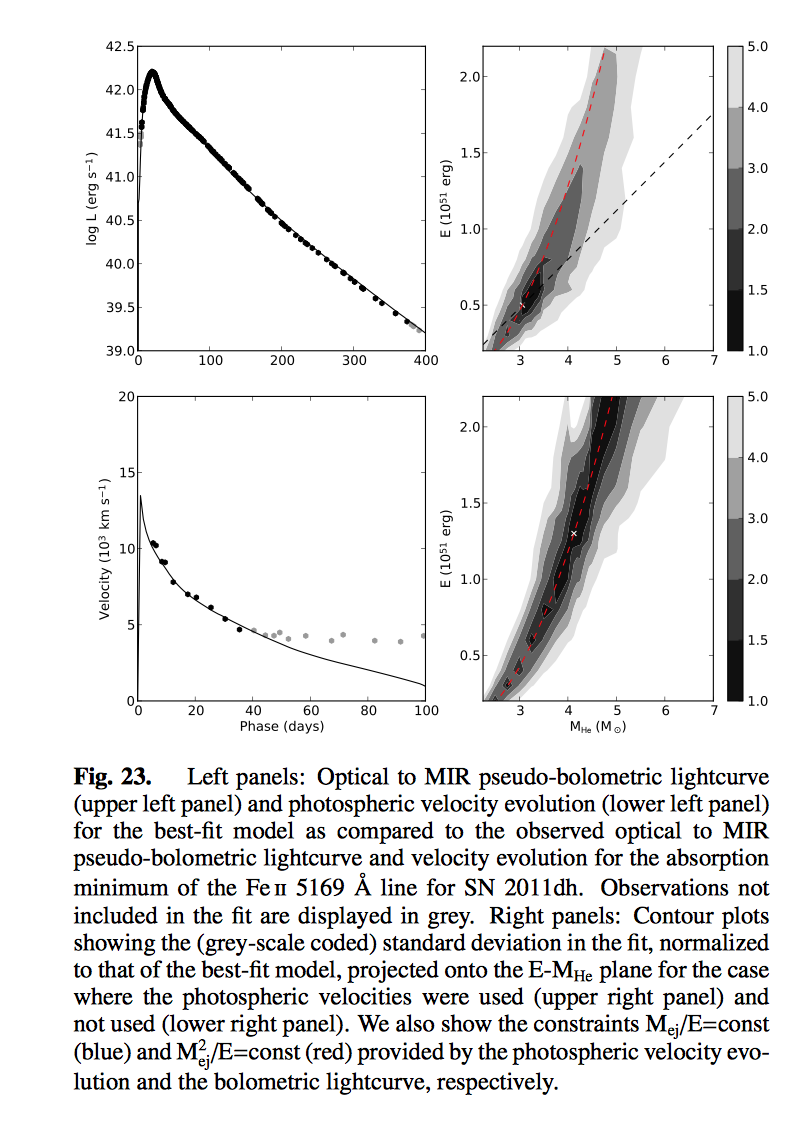Padova-Asiago Supernova Group
Highlights
The Type IIb SN 2011dh - 2 years of observations and modelling of the lightcurves
Ergon, M. etal. 2014, arXiv1408.0731 (link to pdf)
We present optical and near-infrared (NIR) photometry and spectroscopy as well as modelling of the lightcurves of the Type IIb supernova (SN) 2011dh. Our extensive dataset spans 2 years, and complemented with Spitzer mid-infrared (MIR) data, we use it to build a 3-732 days optical to MIR bolometric lightcurve. To model the <400 days bolometric lightcurve we use a hydrodynamical model grid, which allows us to determine the errors in the derived quantities, and a bolometric correction determined with steady-state NLTE modelling. We obtain similar results using the <100 days and <400 days bolometric lightcurves, and using the latter we find a helium core mass of 3.1+0.7 Msun for SN 2011dh. We present 100-500 days bolometric and photometric lightcurves for the Jerkstrand et al. (2014) steady-state NLTE models. The preferred 12 Msun (initial mass) model, presented and found to give a good agreement with observed nebular spectra in Jerkstrand et al. (2014), shows a good overall agreement with the observed lightcurves, although some discrepancies exist. Time-dependent NLTE modelling shows that after 600 days a steady-state assumption is no longer valid. The radioactive energy deposition in this phase is likely dominated by the positrons emitted in the decay of 56Co, but what energy source is dominating the emitted flux is unclear. We find an excess in the K and the MIR bands developing between 100 and 250 days, during which an increase in the optical decline rate is also observed. A local origin of the excess is suggested by the depth of the He i 20581 AA absorption. Steady-state NLTE models with a modest dust opacity in the core (tau = 0.44), turned on during this period, reproduce the observed behaviour, but an additional excess in the Spitzer 4.5 nm band remains. CO first overtone band emission is detected at 206 days, and possibly at 89 days, and assuming the additional excess to be dominated by CO fundamental band emission, we find fundamental to first overtone band ratios considerably higher than observed in SN 1987A. The profiles of the [O I] 6300 AA and Mg I] 4571 AA lines show a remarkable similarity, suggesting these lines to originate mainly from the O/Ne/Mg zone, and using small scale fluctuations in the line profiles we estimate a filling factor of ~0.07 for the emitting material. This paper concludes our extensive observational and modelling work on SN 2011dh. The results from hydrodynamical modelling, steady-state NLTE modelling and stellar evolutionary progenitor analysis are all consistent, and suggest an initial mass of ~12 Msun for the progenitor. We also extend our analysis to SNe 1993J and 2008ax, and the initial masses of ~15 Msun found for SNe 2011dh, 1993J and 2008ax, by hydrodynamical modelling and steady-state NLTE modelling of nebular spectra (Jerkstrand et al. 2014), suggest that all of these Type IIb SNe originates from binary systems, as previously established for SN 1993J. 25
Ergon, M. etal. 2014, arXiv1408.0731 (link to pdf)
We present optical and near-infrared (NIR) photometry and spectroscopy as well as modelling of the lightcurves of the Type IIb supernova (SN) 2011dh. Our extensive dataset spans 2 years, and complemented with Spitzer mid-infrared (MIR) data, we use it to build a 3-732 days optical to MIR bolometric lightcurve. To model the <400 days bolometric lightcurve we use a hydrodynamical model grid, which allows us to determine the errors in the derived quantities, and a bolometric correction determined with steady-state NLTE modelling. We obtain similar results using the <100 days and <400 days bolometric lightcurves, and using the latter we find a helium core mass of 3.1+0.7 Msun for SN 2011dh. We present 100-500 days bolometric and photometric lightcurves for the Jerkstrand et al. (2014) steady-state NLTE models. The preferred 12 Msun (initial mass) model, presented and found to give a good agreement with observed nebular spectra in Jerkstrand et al. (2014), shows a good overall agreement with the observed lightcurves, although some discrepancies exist. Time-dependent NLTE modelling shows that after 600 days a steady-state assumption is no longer valid. The radioactive energy deposition in this phase is likely dominated by the positrons emitted in the decay of 56Co, but what energy source is dominating the emitted flux is unclear. We find an excess in the K and the MIR bands developing between 100 and 250 days, during which an increase in the optical decline rate is also observed. A local origin of the excess is suggested by the depth of the He i 20581 AA absorption. Steady-state NLTE models with a modest dust opacity in the core (tau = 0.44), turned on during this period, reproduce the observed behaviour, but an additional excess in the Spitzer 4.5 nm band remains. CO first overtone band emission is detected at 206 days, and possibly at 89 days, and assuming the additional excess to be dominated by CO fundamental band emission, we find fundamental to first overtone band ratios considerably higher than observed in SN 1987A. The profiles of the [O I] 6300 AA and Mg I] 4571 AA lines show a remarkable similarity, suggesting these lines to originate mainly from the O/Ne/Mg zone, and using small scale fluctuations in the line profiles we estimate a filling factor of ~0.07 for the emitting material. This paper concludes our extensive observational and modelling work on SN 2011dh. The results from hydrodynamical modelling, steady-state NLTE modelling and stellar evolutionary progenitor analysis are all consistent, and suggest an initial mass of ~12 Msun for the progenitor. We also extend our analysis to SNe 1993J and 2008ax, and the initial masses of ~15 Msun found for SNe 2011dh, 1993J and 2008ax, by hydrodynamical modelling and steady-state NLTE modelling of nebular spectra (Jerkstrand et al. 2014), suggest that all of these Type IIb SNe originates from binary systems, as previously established for SN 1993J. 25
